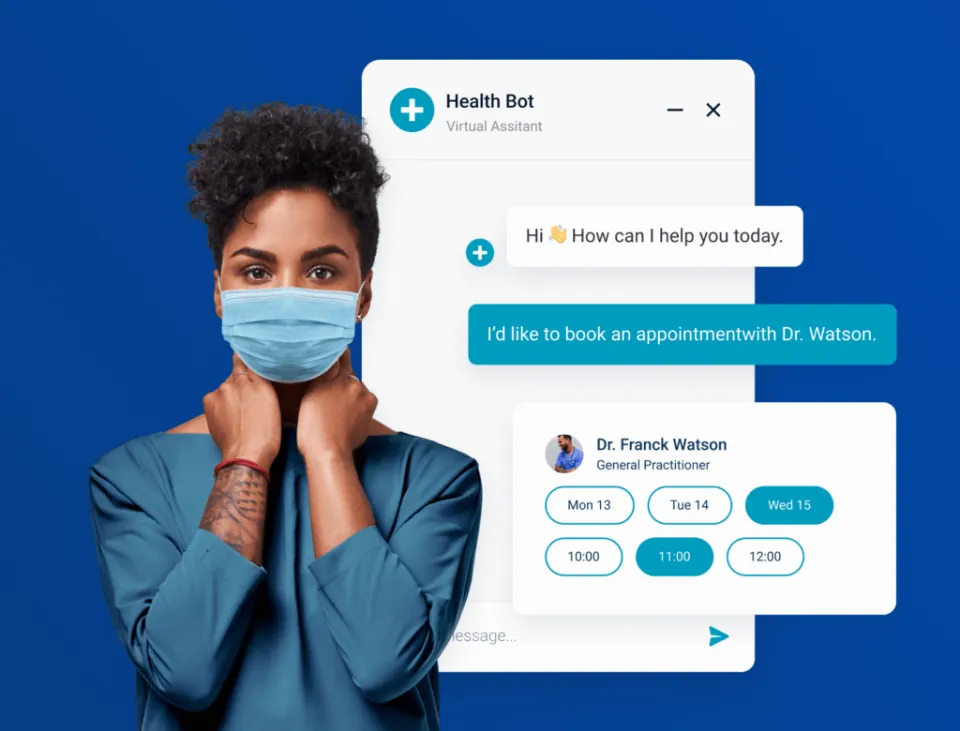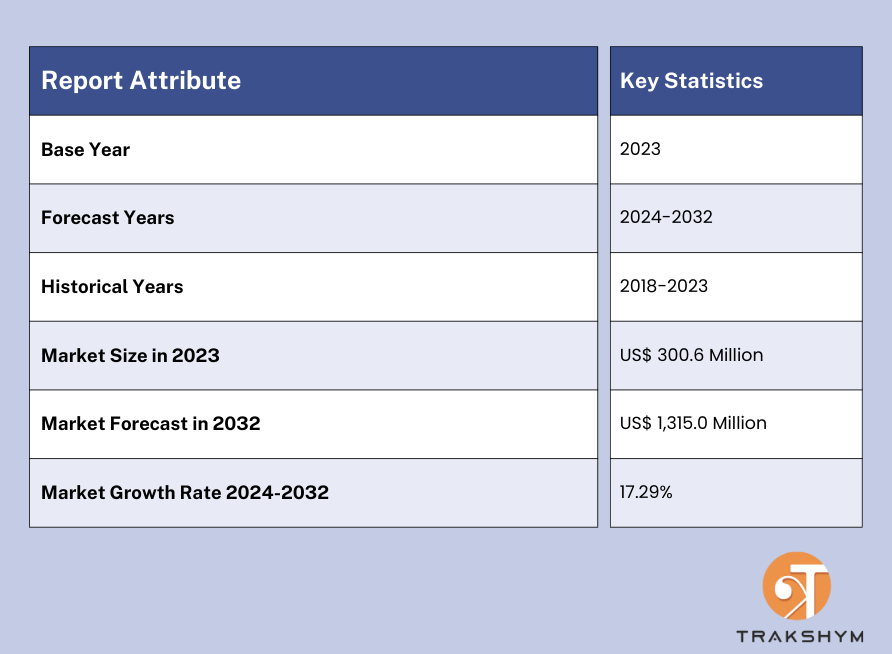How Chatbots Are Revolutionizing Healthcare

Healthcare Chatbots Market Overview:
In 2023, the global healthcare chatbot market reached a value of $300.6 million. Looking ahead, the Trakshym predicts the market will grow to $1,315 million by 2032, with a yearly growth rate of 17.29% from 2024 to 2032. This growth is being fueled by several factors, including the increasing use of digital technology in healthcare, the impact of the COVID-19 pandemic, the rising number of people with chronic illnesses, advancements in natural language processing, support for telehealth from regulators, and the growing need for 24/7 healthcare services.

Healthcare Chatbots Market Analysis:
1. Market Growth and Size:
The global healthcare chatbots market is experiencing robust growth, driven by factors, such as digital technology integration, the impact of COVID-19, and healthcare chatbots market revenue. It is expected to expand continuously notably over the coming years.
2. Major Market Drivers:
Key drivers include the adoption of digital tech in healthcare, the pandemic’s influence, cost-efficiency considerations, the rise in chronic diseases, advancements in artificial intelligence (AI) and natural language processing (NLP), regulatory support, growing patient awareness, and the need for 24/7 healthcare services.
3. Technological Advancements:
Rapid technological advancements in natural language processing (NLP), machine learning (ML), and artificial intelligence (AI) algorithms have significantly enhanced the capabilities of healthcare chatbots which assists in accurate diagnosis, personalized treatment recommendations, and improved patient interactions.
4. Industry Applications:
Healthcare chatbots find extensive applications across various domains, including symptom checking, appointment scheduling, medication reminders, and post-treatment follow-ups, contributing to improved patient engagement and adherence.
5. Key Market Trends:
Notable trends include the increased use of chatbots for symptom assessment, appointment scheduling, and health information dissemination. Additionally, chatbots are increasingly recognized for their role in medical research and data collection.
6. Geographical Trends:
The adoption of healthcare chatbots is growing globally, with regions like North America and Europe leading in implementation due to their mature healthcare systems and regulatory support.
7. Competitive Landscape:
The market features a competitive landscape with numerous players offering chatbot solutions. Leading healthcare chatbots companies are striving to establish themselves as thought leaders and experts in market research and consulting services.
8. Challenges and Opportunities:
Challenges include the need for strict compliance with healthcare regulations and ensuring the privacy and security of patient data. Opportunities lie in the healthcare chatbots market recent developments and the expansion of their use across various healthcare applications.

Key Benefits of Chatbots in Healthcare:
1. 24/7 availability:
It’s not practical to have healthcare staff working around the clock, but this is where chatbots can help. These tools run non-stop, without any delays or breaks.
This is especially important in healthcare because emergencies and health questions can come up at any time. Someone might need information about a symptom, or they could want to check a clinic’s opening hours or see if a doctor is available. Instead of making a late-night call or waiting for a call center representative, they can simply chat with a bot.
While chatbots might not have all the answers, they can easily provide basic information like schedules or answer simple patient questions safely and accurately.
2. Enhanced Patient Engagement:
Patients don’t always have the chance to ask their doctors questions or may not have time during appointments. This can leave them less informed about their condition and unaware of their health status. Thankfully, healthcare chatbots help fill this gap by offering personalized communication. They can remind patients about their appointments or provide short follow-up messages when needed, helping keep patients engaged and informed.
3. Quicker Query Resolution:
People, including those in healthcare, expect quick answers to their questions. When dealing with human specialists, this process can take time. Healthcare chatbots solve this problem by providing instant responses. By answering questions quickly, chatbots help improve the overall experience for patients.
4. Cost Reduction:
Managing costs is always a concern for healthcare organizations, and AI chatbots offer a great solution. By automating routine tasks, chatbots reduce the need for human labor. They also help cut down costs linked to losing patients or inefficiencies. The faster service they provide allows more patient requests to be handled at once, which can increase revenue.
5. Accessibility and Convenience:
With more services going digital, people expect faster and easier options, and healthcare is no different. Chatbots in healthcare are easy to access from anywhere and on different devices. This is especially helpful for patients in remote areas, where access to quality care can be limited.
6. Data Collection and Analysis:
A major benefit of using healthcare chatbots is the valuable data they can collect. Through interactions with patients, chatbots can gather information on symptoms, common questions, areas for improvement, and other patient preferences. This data can then be analyzed to spot trends and predict possible health issues, helping healthcare providers adjust their services to meet patients’ changing needs.
Applications of Chatbots in Healthcare:
1. Appointment Scheduling:
One of the most common and useful ways chatbots are used in healthcare is for scheduling appointments. There’s no need for staff to spend time arranging appointments for patients — chatbots can handle it quickly and easily. Patients can choose their preferred appointment time without the hassle of long phone calls or waiting at the front desk. Automating this task helps reduce the workload for healthcare staff.
2. Symptom Assessment:
One growing use of chatbots in healthcare is helping assess symptoms and guiding patients on the care they need. For example, during the coronavirus pandemic, WHO’s chatbots reached over 12 million people, and the global impact was even larger.
Patients provide basic details like their age and gender, which helps the chatbot understand how these factors may affect their symptoms. They then describe their symptoms using words like “stomach,” and the bot suggests related keywords. Based on the input, the chatbot offers possible symptoms.
Once the patient selects the most relevant option, the bot may ask follow-up questions about the severity of the condition and if it’s improving. After this, the chatbot can recommend what to do next and which doctor to see.
3. Medication Management:
Many people use healthcare chatbots to help manage their medications and stay on top of their routines. This feature can be especially useful for businesses developing a chatbot, as it offers timely reminders and helps patients track their dosages.
This area of healthcare chatbots is a good opportunity for new businesses, with user interest expected to reach 4.75% by 2029. This means healthcare providers have a growing chance to connect with more patients. Patients can use the chatbot to confirm they took the right amount of medication and keep track of their prescriptions.
4. Patient Data Collection:
Collecting and processing patient data can greatly improve a healthcare provider’s services. Healthcare chatbots gather important information like demographics and symptoms, which helps in creating better services and targeting specific patient needs.
This data can also be added to patients’ electronic health records (EHRs), giving healthcare providers fresh insights to enhance patient care.
5. Mental Health Support:
Many patients are turning to healthcare chatbots for mental health support because they offer anonymity, making it easier to share their struggles with a non-human partner. While a chatbot can’t replace a real therapist, it can provide quick responses and empathetic interactions, which can be really helpful for improving outcomes.
These chatbots often include mood trackers and journaling features, as well as tips for mental health and encouragement for healthy coping strategies.
6. Chronic Disease Management:
After being discharged from the hospital, many patients, especially those recovering from surgeries or tough treatments, often struggle to adjust to their everyday lives. Healthcare chatbots can help meet this need by supporting patients as they regain their footing. By providing reassurance and answering urgent questions, chatbots can improve long-term health outcomes and lower the risk of complications.
Conclusion:
Healthcare chatbots are transforming the way patients interact with healthcare systems by providing 24/7 availability, enhancing patient engagement, and offering quicker query resolution. They help reduce costs, improve accessibility, and facilitate medication management while also collecting valuable patient data. Additionally, chatbots support mental health and assist in managing chronic diseases, making them an essential tool for modern healthcare. As the technology continues to evolve, the benefits of chatbots will only grow, helping to create a more efficient and patient-centered healthcare experience.
Are you interested in enhancing your hospital operations? Contact us to discover how our healthcare chatbot can make a difference in your services!
View More tech Blogs at https://trakshym.com/blog/
